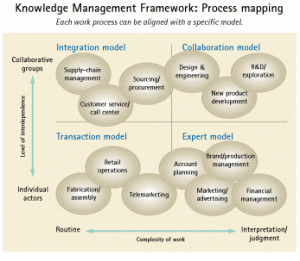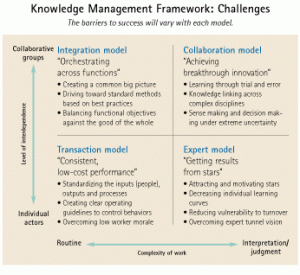Knowledge management strategies that create value
A firm that had invested millions of dollars in a state-of-the-art intranet intended to improve knowledge sharing got some bad news: Employees were using it most often to retrieve the daily menu from the company cafeteria. The system was barely used in day-to-day business activities.
Few executives would argue with the premise that knowledge management is critical—but few know precisely what to do about it. There are numerous examples of knowledge-management programs intended to improve innovation, responsiveness and adaptability that fall short of expectations. Researchers at the Accenture Institute for Strategic Change have been exploring the roots of the problem and have developed a method to help executives make effective knowledge management a reality in their organizations.
Much of the problem with knowledge management today lies in the way the subject has been approached by vendors and the press. Knowledge management is still a relatively young field, with new concepts emerging constantly. Often, it is portrayed simplistically; discussions typically revolve around blanket principles that are intended to work across the organization. For example, companies are urged to emulate knowledge-management leaders such as British Petroleum and Skandia. And most knowledge-management initiatives have focused almost entirely on changes in tools and technologies, such as intranets and Lotus Notes.
These approaches have little relevance for executives contending with the day-to-day reality of running a company. Knowledge management is complex and multifaceted; it encompasses everything the organization does to make knowledge available to the business, such as embedding key information in systems and processes, applying incentives to motivate employees and forging alliances to infuse the business with new knowledge. Effective knowledge management requires a combination of many organizational elements—technology, human resource practices, organizational structure and culture—in order to ensure that the right knowledge is brought to bear at the right time.
Many companies have implemented sophisticated intranets, common repositories and other systems, largely ignoring the complex cultural issues that influence the way people behave around knowledge. By and large, those companies have seen little improvement in their ability to manage knowledge. Too often, companies implement state-of-the-art technology and then discover that culture and behavior are slow to change.
In short, simplistic solutions and “one-size-fits-all” approaches leave executives with little in the way of practical advice about how to transform the entire knowledge-management system. What’s more, this fuzziness makes it difficult for executives to see a clear link between their knowledge-management investments and business value.
To help executives, the Institute has developed a framework that associates specific knowledge-management strategies with specific challenges that companies face. This Knowledge Management Framework is based on the premise that the focus should be placed on the way knowledge is used to build the critical capabilities a company needs in order to succeed—on the core processes and activities that enable it to compete. Enhancing a bank’s know-how in evaluating credit risk, for example, should result in reduced loan losses; improving a consumer products company’s understanding of customer preferences should increase its percentage of successful new products.
The framework begins by assessing and categorizing the way work is done in the core process. Work can be evaluated along two dimensions. First is the level of interdependence involved—that is, the degree to which individuals and organizations need to collaborate and interact. Second is the complexity of work involved—the degree to which employees need to apply their judgment and interpret a variety of information. Using these two factors, the Institute has identified four distinct categories of work, or “work models”:
- Transaction model, in which there is a low degree of both interdependence and complexity. Work is typically routine, highly reliant on formal rules, procedures and training, and depends on a workforce that exercises little discretion.
- Integration model, in which there is a high degree of interdependence and a low degree of complexity. Work is systematic and repeatable, relies on formal processes, methodologies and standards, and depends on tight integration across functional boundaries.
- Expert model, in which there is low interdependence and high complexity. Work requires judgment and is dependent on “star performers.”
- Collaboration model, in which there is a high degree of both interdependence and complexity. Work involves improvisation and learning by doing, and relies on deep expertise across functions and the use of flexible teams.

Key to Understanding
In general, a given core process can be mapped to one of these four categories. For example, supply-chain management and procurement tend to fit into the integration model; the work in these processes is often routine, and activities generally span multiple functions and organizations. In comparison, marketing and financial management tend to be expert model work, requiring individuals in one functional area to apply their judgment to solve unanticipated problems.
However, it is important to note that there are no hard-and-fast connections between a certain core process and a work model, because the same process can be performed in different ways. Sales, for example, can refer to individuals covering their respective territories (expert model) or to a supplier’s multifunctional team working closely with a customer to maintain retail inventories (integration model). So the key is to understand how work is performed; it is the nature of the work that determines the appropriate knowledge-management approach.
Knowing the work model that’s associated with the core process is important because each model presents its own distinct set of knowledge-management challenges. In the collaboration model, for example, a key challenge is the achievement of breakthrough innovation. To drive such innovation, a company needs to encourage risk-taking and bring together a variety of knowledge domains, such as research, product development, marketing and manufacturing, in order to solve complex problems. At one biotech company, the Institute found that increasingly complicated projects and the need for a growing number of scientific disciplines was making it harder to integrate activities into a coherent whole. Every point in the chain needs to know not just what the links above and below are, but also needs to have some idea of what the whole continuum is.
In the expert model, on the other hand, the organization usually needs to focus on getting results from its star performers. To do so, companies must contend with issues such as attracting and motivating talented individuals and overcoming “silos” of information. For example, at one expert model company studied by the Institute, individuals had a tremendous amount of knowledge about products, but each person rarely knew what the others were doing. In one product area, managers discovered seven redundant research projects.
In essence, the framework allows executives to gain a better understanding of their current knowledge-management practices—which in most companies have evolved in an ad hoc, unconscious manner—and to identify the knowledge-management challenges associated with their core processes. From that specific diagnosis, it is a short step to prescribing specific remedies, because each set of challenges points to a handful of potential knowledge-management strategies.
For example, the challenges in the transaction model are centered on the need to codify knowledge and ensure consistent performance. Possible knowledge-management strategies would therefore include “automation” that embeds knowledge in systems, or perhaps “routinization,” in which knowledge is built into policies and procedures, and training is aimed at standardizing workers’ behavior. In the integration model, where the challenge is to orchestrate activity across various parts of the organization, executives might consider the adoption of standard processes or methodologies that integrate performance across functions. Or they might use softer measures that focus on the use of cross-functional teams, shared goals and feedback systems.

In the expert model, knowledgeable individuals are key. Here, executives may recruit star performers away from other companies, or may choose to focus on programs that develop stars internally through long-term career-progression programs, apprenticeships, mentoring and training. And in the collaboration model, where the challenges revolve around creating breakthrough innovations, the choices may include “action-learning” strategies that encourage discovery through “skunkworks” and pilots, or “knowledge-linking” strategies that focus on learning through consortia and alliances.
The framework also makes it possible to address all elements of the knowledge-management system as a whole—technology, human resource practices, organization and culture—because it focuses executives’ attention on the capabilities their organizations need rather than on component solutions. Also, attention is shifted from broad, vague issues to a well-defined set of challenges that are specific to their business. They have a manageable number of targeted options from which to choose, which makes it easier to formulate an integrated approach to changing organizational structure, technology, human resources and the world culture.

In addition to guiding improvements in today’s core processes, the framework can also be used to help companies evolve and adapt to new conditions. Markets, customers, technology and competition are always changing. To thrive, companies must change over time as well, or their core capabilities may well become core rigidities that lead to obsolescence. As they strive to move in new directions, executives can use the framework to understand the knowledge-management systems that new capabilities will require.
In the silicon-chip industry, for example, the design of new microchip manufacturing processes has always been considered something of an art—a collaborative model type of effort involving a small cadre of experts, extensive experimentation and rapid learning to get it right. Now, however, with most personal computers selling for less than $1,000, chip makers need to move to lower-cost approaches—and to an integration model of knowledge management, where the focus is on standardization, repeatable work and continuous improvement. The framework can help companies envision what their new knowledge-management approach should look like under their new strategy, and plot out a path that will take them there.
At one highly successful financial services company, executives are using the framework to help identify today’s knowledge-management challenges and constraints in the area of product development, and to help shape the company’s approach to tomorrow’s products. Currently, the company develops products under an expert model, with knowledgeable individuals driving the process. Although this model has been appropriate for incremental product development—essentially, enhancements and extensions of existing offerings—it has rarely produced a real product innovation.
The company believes that it may be falling behind in terms of bringing true breakthrough products to market, particularly in the area of eCommerce. Executives want to build on traditional strengths to keep improving existing products, but they also recognize that they will need to take a different approach if the company is to maintain product leadership in its industry. So in the creation of electronic commerce products, the company is considering a move toward the collaboration model and the use of a skunkworks-style operation that relies on multidisciplinary teams and team incentives, rather than individual experts.

Executives are also beginning to experiment with external alliances as a way to bring new knowledge into the company. Using the framework as a guide, the company has been able to gain a sophisticated understanding of how to improve its current knowledge-management systems and, at the same time, develop a sense of how it can manage knowledge to forge new capabilities for the long term.
That kind of evolutionary ability will become increasingly important in the coming years, as the demands of new markets and new competitors drive continuing shifts in corporate strategies. To support those strategies, companies will have to build new capabilities more and more rapidly—and so the ability to manage knowledge to support that change will be critical.
SOURCE : www.accenture.com/Global/…and…/Knowledgevalue.htm

No comments:
Post a Comment